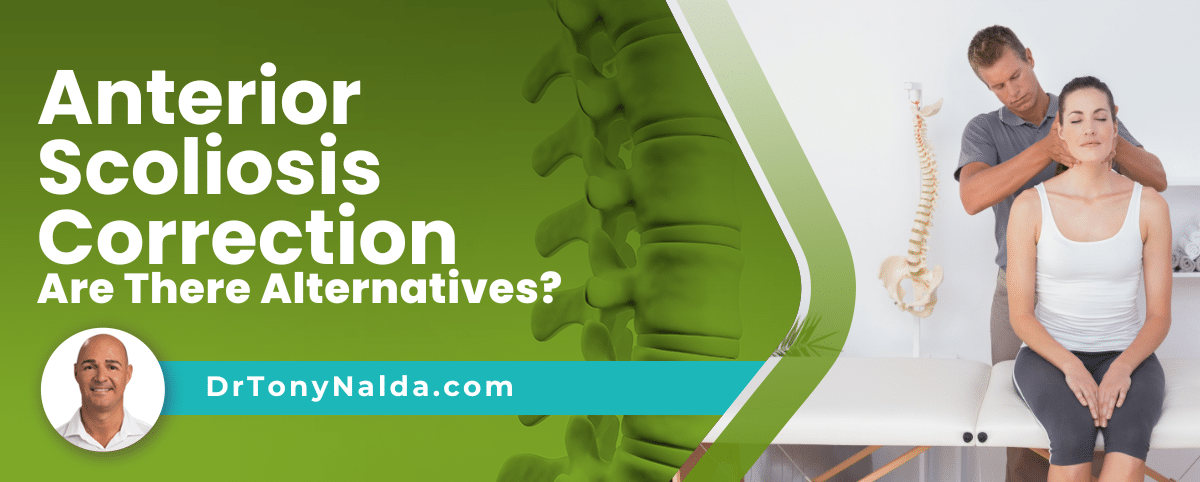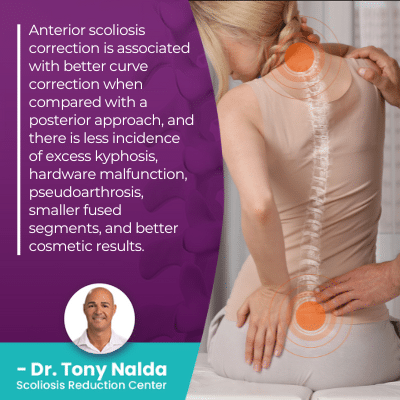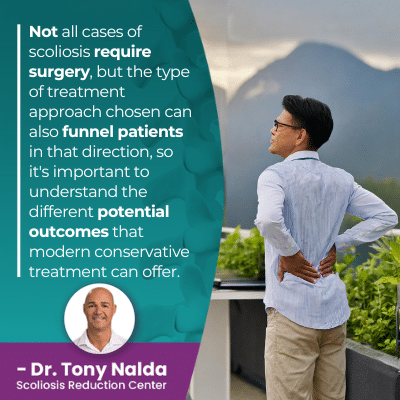Anterior Scoliosis Correction: Are There Alternatives?

Scoliosis doesn't always require surgery; the proven success of conservative scoliosis treatment speaks to this. When it comes to a surgical response to scoliosis, this involves spinal fusion, and the spine can be accessed from the back of the body (posterior) or the front (anterior). There are some benefits associated with anterior scoliosis correction.
Anterior scoliosis correction is a type of spinal fusion, which is a surgical procedure applied in traditional scoliosis treatment to stop progression. There are surgical alternatives to an anterior spinal fusion, and alternatives to a surgical response.
As the two main scoliosis treatment approaches are surgical and nonsurgical, let's explore the pros and cons of each.
Table of Contents
Understanding Scoliosis Treatment Options
When it comes to understanding scoliosis treatment options, this is crucial because as a progressive condition, how a diagnosis of scoliosis is responded to will shape long-term spinal health and function.
As scoliosis develops, an unnatural sideways-bending and rotating spinal curve is developing, and as a progressive condition, the nature of scoliosis is to get worse over time; scoliosis ranges in severity from mild to moderate and severe to very severe scoliosis.
When diagnosed and treated early, there are fewer limits to what can be achieved, but there are no treatment guarantees.
When a diagnosis is given, patients have an important decision to make: which of the two main scoliosis treatment approaches to commit to.
Traditional scoliosis treatment offers a surgical response, while conservative treatment offers a nonsurgical treatment alternative.
A surgical response means spinal fusion, and this is a costly, invasive, risky, and lengthy procedure with an intense recovery process, and it can cost the spine in terms of its long-term health; nonsurgical scoliosis treatment is noninvasive and doesn't disrupt the spine's natural strength and/or function.
So let's talk first about the procedure of spinal fusion and the difference between a posterior and anterior approach.
Anterior Scoliosis Correction vs Posterior Scoliosis Correction
A surgical response to a diagnosis of scoliosis is spinal fusion, and this is performed with the goal of stopping progression.
Spinal fusion involves fusing the curve's most-tilted vertebrae into one solid bone, and this commonly involves the removal of intervertebral discs that sit between adjacent vertebral bodies to be fused, commonly involving a bone graft (allograft bone).
Rods are attached to the spine with pedicle screws to hold it in place, and this means that the vertebrae fused can't become more tilted over time (progression), and even within the procedure of spinal fusion, there are different techniques and approaches.
 In posterior scoliosis correction, the spine is accessed through the back, but this means the surgeon has to travel farther to access the vertebral bodies being deformed, and this can mean cutting through muscle, whereas an anterior scoliosis correction approach accesses the spine from the front of the body and has a number of benefits.
In posterior scoliosis correction, the spine is accessed through the back, but this means the surgeon has to travel farther to access the vertebral bodies being deformed, and this can mean cutting through muscle, whereas an anterior scoliosis correction approach accesses the spine from the front of the body and has a number of benefits.
Each patient will respond differently to scoliosis surgery, but one factor that shapes recovery time is the number of vertebrae fused; in general, the more vertebrae fused, the more invasive the procedure is and the lengthier recovery will be.
In addition, the main complaint of patients post spinal fusion is that they have lost a noticeable degree of spinal flexibility and range of motion, and this effect is also shaped by the number of vertebrae fused.
When the spine is accessed through the front, the surgeon is closer to the vertebrae, and this approach is associated with a short segment fusion.
Anterior scoliosis correction is associated with better curve correction when compared with a posterior approach, and there is less incidence of excess kyphosis, hardware malfunction, pseudoarthrosis, smaller fused segments, and better cosmetic results.
When it comes to a surgical procedure treating scoliosis, there is an anterior scoliosis correction alternative, and that's known as a vertebral body tethering system.
Vertebral Body Tethering
There are many innovative surgical techniques, and vertebral body tethering is one of them, and this approach is known to be particularly effective on growing spines, and this is important because the most prevalent type of scoliosis is adolescent idiopathic scoliosis, diagnosed between the ages of 10 and 18.
This is seen as a less-invasive surgical treatment alternative because it accesses the spine from the side through small incisions known as portals, through which a camera and scope are passed for visualizing the spine and guiding the surgeon.
Screws are attached to the spine through the portals, and a flexible tether is attached to the screws; the idea is that as the tension on the tether is adjusted, it pulls the spine into a straighter alignment, and the tension holds it in that position, preventing further progression.
The benefit to vertebral body tethering is that tension can be adjusted as the spine responds to growth, so this is ideal for adolescent patients or patients who have not yet reached skeletal maturity; tether breakage is a risk, however, and the long-term effects of this approach are still being studied.
But what about patients who are looking for a less invasive treatment option, a non-surgical treatment alternative?
Nonsurgical Conservative Scoliosis Treatment
Not all cases of scoliosis require surgery, but the type of treatment approach chosen can also funnel patients in that direction, so it's important to understand the different potential outcomes that modern conservative treatment can offer.
 Traditional surgical treatment was the dominant choice for many years, but that doesn't mean it was the best or only treatment option available, and conservative treatment has proven results that show how effective a chiropractic-centered approach can be.
Traditional surgical treatment was the dominant choice for many years, but that doesn't mean it was the best or only treatment option available, and conservative treatment has proven results that show how effective a chiropractic-centered approach can be.
Spinal surgery is risky, and in addition to how scoliosis surgery affects long-term spinal health and function, there are also risks associated with the procedure itself: infection, excessive blood loss, nerve damage, adverse reaction to hardware and tether material.
Here at the Scoliosis Reduction Center, my patients benefit from a conservative chiropractic-centered approach to scoliosis treatment, and this approach integrates multiple scoliosis-specific treatment disciplines including chiropractic care, physical therapy, corrective bracing, and rehabilitation.
Chiropractic care involves a series of techniques and manual adjustments that have the goal of adjusting the position of the vertebrae at the curve's apex (these are the most unnaturally tilted), and physical therapy is a key facet of treatment that also involves the prescription of scoliosis-specific exercises (SSEs).
Through physical therapy and exercise, patients can work towards increasing core strength so the spines are better supported and stabilized by their surrounding muscles, improving brain-body communication by activating specific areas of the brain, improving posture and body positioning.
Corrective bracing is known as particularly effective on growing spines so is typically a facet of treatment for pediatric scoliosis.
Rehabilitation can involve continued chiropractic care and scoliosis-specific exercises that are prescribed to be done from home to further heal and stabilize the spine for long-term sustainable treatment results.
When nonsurgical scoliosis treatment is successful, the condition's underlying structural nature is addressed through curve correction, spinal support and stabilization is increased, and this is achieved while preserving as much of the spine's natural strength and function as possible.
Conservative treatment offers an alternative to invasive scoliosis surgery because regardless of the type of surgery performed, all spinal surgeries come with their share of potential risks, side effects, and complications, so should be considered carefully.
Conclusion
The primary difference between anterior scoliosis correction and posterior scoliosis correction is how the spine is accessed; anterior means the spine is accessed through the front of the body, posterior refers to accessing the spine through the back, and vertebral body tethering involves accessing the spine from the side.
The benefit of anterior scoliosis correction asc over posterior correction is that accessing the spine from the front puts the surgeon closer to the vertebral bodies, is better for muscle sparring, and curve segments to be fused tend to be shorter.
The longer a fused portion of the spine is, the more likely it is to cause noticeable effects such as a loss in spinal flexibility, range of motion, and increased pain at the fusion site.
An alternative to traditional spinal fusion that involves a single or double rod and pedicle screws is known as vertebral body tethering, and this involves adjusting the position of the spine through adjusting tension on an attached tether, and this approach is particularly effective on growing spines as tension can be adjusted throughout growth and progression.
The best alternative to surgical procedures for treating scoliosis, however, involve modern conservative treatment with proven results, and this approach helps keep a flexible spine, maintains spinal mobility, and addresses a patient's scoliosis proactively by starting treatment as close to the time of diagnosis as possible.
Progressive scoliosis needs to be taken seriously because conditions only become more complex to treat the more they progress, and while adult patients have the progressive trigger of growth removed, they have natural age-related spinal degeneration that can increase rates of progression in adults.
There are no treatment guarantees with any given treatment approach, but scoliosis that's treated conservatively is known to respond to early detection and intervention favorably, so if a diagnosis of scoliosis is reached, the most important decision to be made is how to treat it moving forward, and being proactive is associated with treatment success.
Dr. Tony Nalda
DOCTOR OF CHIROPRACTIC
After receiving an undergraduate degree in psychology and his Doctorate of Chiropractic from Life University, Dr. Nalda settled in Celebration, Florida and proceeded to build one of Central Florida’s most successful chiropractic clinics.
His experience with patients suffering from scoliosis, and the confusion and frustration they faced, led him to seek a specialty in scoliosis care. In 2006 he completed his Intensive Care Certification from CLEAR Institute, a leading scoliosis educational and certification center.
About Dr. Tony Nalda
 Ready to explore scoliosis treatment? Contact Us Now
Ready to explore scoliosis treatment? Contact Us Now





